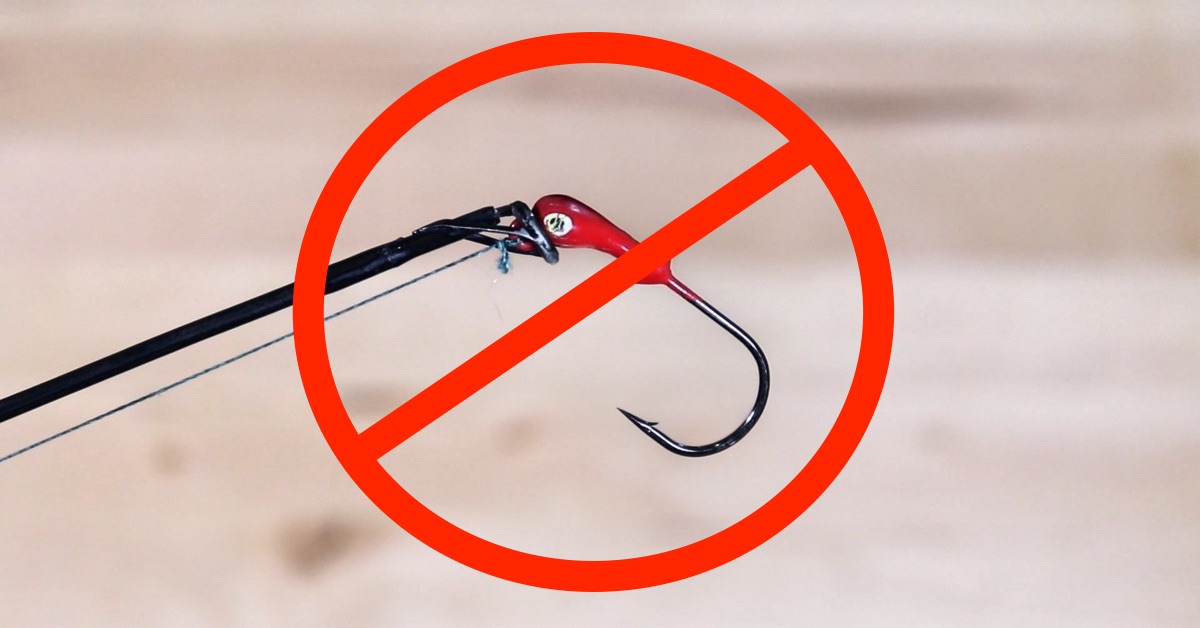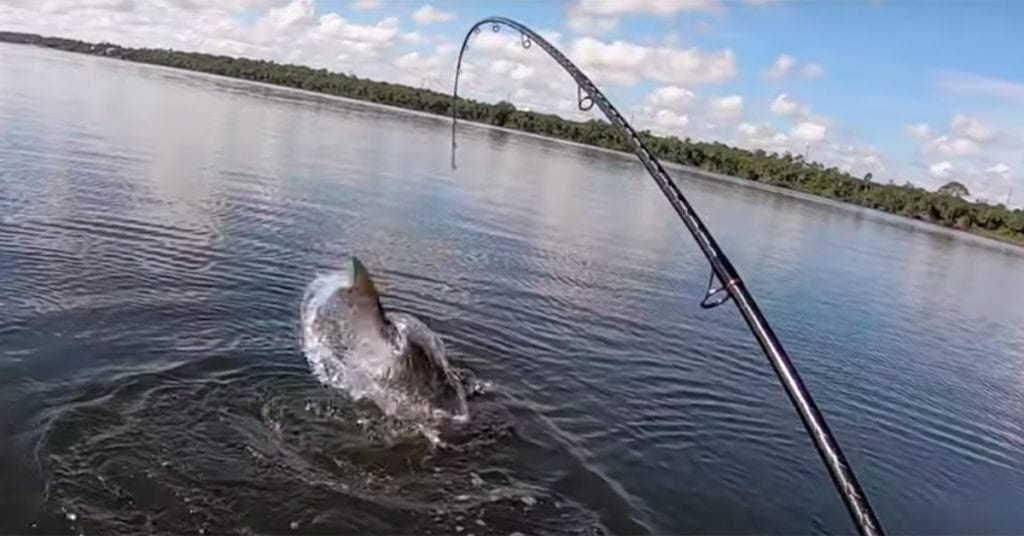7 Fishing Rod Mistakes To AVOID (To Make Your Rods Last Longer)
- By: Tony Acevedo
- on
- Found In: *Tackle & Gear, Fishing Tips, WEEKLY NEWSLETTER: 2-14-21

Have you ever had a rod break “out of the blue”?
Maybe you were hooked into a big fish or snagged on the bottom, and it suddenly snapped…
Here’s the thing: rods don’t normally break “out of the blue”.
There are usually little things that happen over time that lead up to them finally breaking.
And those little things are usually the rod owner’s fault.
But here’s the good news: most of them are preventable!
And in this video, I’ll show you what the biggest makes people make that cause their rods to break and how to avoid them.
Let’s dive in!
What NOT To Do With Your Rods [VIDEO]

Here’s what NOT to do when using, transporting, or storing your fishing rods:
#1: Don’t use a new rod before inspecting it
Rods are shipped either to your home or to the store you bought them from and if those rods aren’t packaged securely, it can mean bad news later.
Small nicks or fractures can happen during transit that can create weak points.
And if you have a big fish on, those weak points can cause the rod to break.
When you purchase a rod, inspect it from top to bottom and make sure there are no weak points.
Also, inspect the guides.
Make sure they’re not bent and there are no nicks in the guide inserts.
Take a Q-tip and run it inside of each guide.
If the cotton on the Q-tip snags, then there’s a nick in the guide and that could cut your line.
#2: Don’t reel the swivels, hooks, or jig heads through or to the tip
When swivels go through the tip or jig heads smash against it, you’re just asking for it to break.
Be sure to stop reeling before any hardware touches the tip.
#3: Don’t store your hook or jig head in the guides or guide frames
When you store them inside the guides, they can bounce around and nick them.
When that happens, the nicks can easily slice your line, causing you to lose a big fish.
Don’t store them in the guide frame either, because that can bend the rod guide.
The ideal scenario is to get a rod with a hook keeper and place your jig heads or hooks there.
#4: Don’t keep the drag too tight when the hook is in the hook keeper
This will put too much pressure at an angle where the rod is not designed to withstand a lot of pressure.
#5: Don’t store heavy jig heads or rigs with weights in your hook keeper
They can bounce around during transport and potentially fracture your rod.
But if you really don’t want to take off the weights or jig head, then here are two possible solutions:
- Use a gear tie to keep the weight snug against your rod so it won’t bounce around.
- Wrap electrical tape around the rod to protect it against the weights.
#6: Don’t lay down your rods in your truck bed or boat
They can bounce into each other which can potentially lead to small nicks.
Instead, keep them secure apart, or keep them secure together with gear ties.
#7: Don’t hold your rod too high up
If you hold your rod too high above the handle, it’ll put more pressure on the rod than it’s designed for and snap.
The same thing goes for high sticking your rod.
Conclusion

When protecting your fishing rods, it all comes down to minimizing impacts that can cause small fractures.
You might not notice them at first, but these little nicks can add up and cause your rod to break under the pressure of a big fish.
Have any questions about taking care of your rods?
Or have any other tips for taking care of them?
Let me know down in the comments.
And if you know someone who wants to stop having rods break on them, please TAG or SHARE this with them!
P.S. Want access to our best fishing spots and tips, plus discounts to our online tackle store? Click here to join us in the Insider Club!
Related articles:
- HOW TO PROPERLY PAIR YOUR INSHORE SPINNING ROD & REEL
- IS YOUR SPINNING REEL REALLY MADE FOR SALTWATER? FIND OUT…
- KNOW YOUR REEL SIZES (PROS & CONS OF 1000 VS 2500 VS 3000 REELS)
Disclaimer: When you buy through links on our site, we sometimes earn affiliate commission from places like Amazon, Bass Pro, Tackle Warehouse, etc. It’s one more way we can help you quickly find the best deals on the web while making sure we’re still around to serve you for years to come (and you do want us to be around to help you catch fish for many more years, right)?
Related categories:
STOP WASTING TIME ON THE WATER!
Do what the “SMART ANGLERS” are doing and join the Insider Club.
Here’s what you’ll receive today when you join:
- Weekly fishing reports and TRENDS revealing exactly where you should fish every trip
- Weekly “spot dissection” videos that walk you through all the best spots in your area
- Exclusive fishing tips from the PROS you can’t find anywhere else
- Everything you need to start catching fish more consistently (regardless if you fish out of a boat, kayak, or land).










Using a bead to stop reeling lures up all the way will the bead itself cause possible damage
Yes, any hard material coming in contact with the inserts on the guide can cause possible damage.
Is there anything you would recommend for a stopper instead then
Not that would be practical. I would suggest just being cautious when you reel the lure up, leave at least a foot of line out between the lure and rod tip.
Lot’s of good info. I noticed you had many thoughts on what not to do with your hook. If you don’t have a hook keeper, what is your recommendation for securing the hook?
Hey John!
You could make a do-it-yourself hook keeper, such as the one shown in this article here:
https://saltstrongdev.wpengine.com/articles/diy-hook-keeper/
Tony what are thoughts on rod cover,, and would you still secure if using?
Rod covers/sleeves are great for protecting the rod. Keeps the rods from banging into each other, keeps the guides from getting snagged, keeps line from getting caught on something, etc.
You definitely want to secure a rod that has a sleeve on it because the sleeve will act as a sail and send the rod flying if you are transporting them on the boat or truck bed. If you have them laying inside an SUV or what not you can let the rods lay there. Just make sure there isn’t anything that could fall onto them or slide into them, like a cooler or box.
Another tip I’d give is to not leave them outside or worse in a shed without environmental controls.
For sure!
good point Allen
Inspecting ANY new rod before purchase is a must.
And … it’s ESPECIALLY important when you get one from a Walmart or other retail shop. I’ve seen customers “testing” a rod in very strange (and potentially destructive) ways, then putting it back on the rack.
Bad news for the unsuspecting angler who ends up purchasing it.
For sure! Being an ex-bass pro shop employee that worked in the warehouse, I have seen some cringeworthy handling of rods just by employees before they even hit the shelf. So definitely inspect!
Hey Tony, is it bad to store the rods, like I do, on ceiling hooks? They are supported horizontally on two plastic hooks and I notice you guys all store yours vertically
Hey Victor!
I don’t see a problem with that. Storing them horizontally after a trip is actually better for the reel because it allows excess water to run off and not seep into the reel if it was standing straight up. I would just be careful if the hooks are bare metal as you could possibly fracture the rod blank. If so, I would wrap the hooks with some type of rubber tape (like electrical tape). Vertical rod storage is just easier for me as I don’t have much ceiling or wall space.
Great video. Could u do a video on how to lubricate and oil reels or any other preventive maintenance we could do. I know Luke did a video on how to wash rods and reels, but want to make sure I am doing what I need to do.
We use spinners and baitcasters (and trollers) in case the advice is different.
Thanks Phillip!
Here is a video on maintaining a reel:
https://saltstrongdev.wpengine.com/articles/preventative-fishing-reel-maintenance/
Thanks Tony!
The electrical tape is a good idea. I suggest the use of rubber electrical splicing tape. it has cushion to it, where the typical “electrical tape” does not. If you don’t have a hook keeper cut a “U” segment from a paper clip, bend a small “rocker” to it and attatch it with your 2nd wind of splicing tape.
Self-fusing silicone tape is even better than electrical tape. Self-fusing tape doesn’t use any adhesive, but it sticks tenaciously to itself as you wrap it around the rod.
Very Interesting I’ve never heard of that stuff before. Thanks Andy!
Hi Tony, check out tackletour.com “Rescue Tape”. I’ve used silicone tape for years. Many different
brands. Always in the car, boat and backpack. Fixed broken rods, leaking gas lines, wiring issues, etc.
Sounds interesting, i’ll definitely check it out! Thanks Scott!
Good stuff Louie thanks for the tip!
Nice tips Tony. If only I could always remember to remove my rods from the upper rod holders on my T-top before motoring into my boat house…………. 🙂
Thanks Bob!
Haha yes that could be a problem!
Thanks for the tips, Tony! While my rods aren’t anything special or expensive, I will definitely start treating them better…I’ve been a bad rod owner!
You’re welcome Amy! Expensive or not, you definitely want them to last!